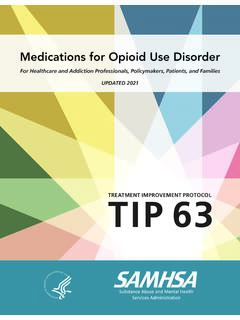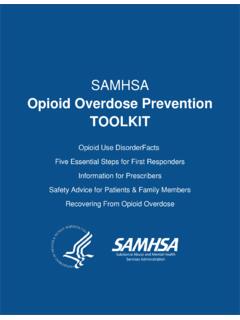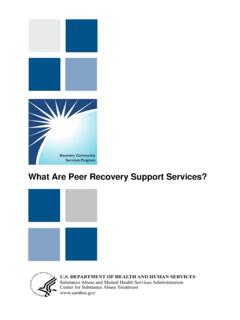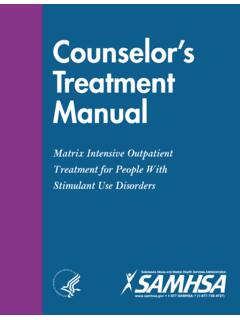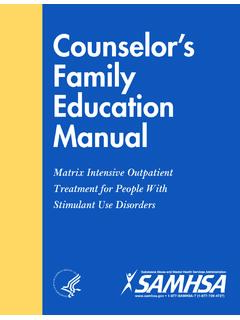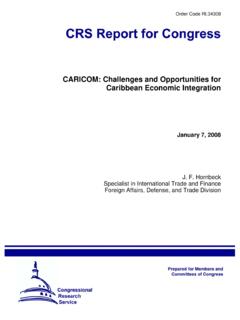Transcription of In Brief: Rural Behavioral Health: Telehealth Challenges ...
1 In Brief Fall 2016 Volume 9 Issue 2. Rural Behavioral Health: Telehealth Challenges and opportunities This In Brief looks at common acceptability, availability, and accessibility barriers to mental and substance use Exhibit 1. Telehealth Across the disorder ( Behavioral health) treatment and services in Behavioral Health Continuum of Care2,3,4,5,6. Rural * communities and presents ways Telehealth can Service Telehealth Example help surmount some of these barriers. Challenges to Assessment Online substance use implementing effective Telehealth services in sparsely questionnaire populated areas are also discussed. This information is Treatment Cognitive Behavioral therapy designed to be useful to Behavioral health practitioners and through videoconferencing many other professionals such as attorneys, Behavioral Medication Text message reminders to take health training program faculty, clergy, pharmacists, management/ medications as directed and primary care practitioners who are concerned monitoring with Behavioral health in their communities.
2 These Continuing care Group chats for relapse professionals may be local centers of influence to whom prevention others turn for Behavioral health information and help. For Education Webinars for clients and more information on the use of Telehealth for Behavioral providers health services, see Treatment Improvement Protocol Collaboration Interactive video for consultation (TIP) 60, Using Technology-Based Therapeutic Tools in Behavioral Health The term Telehealth refers to using internet and Nearly one in five residents lives in a Rural communications technologies (ICTs), such as According to most estimates, individuals living in Rural videoconferencing, chat, and text messaging, to provide locations experience mental and substance use disorders health information and treatments in real time. Telehealth at rates that are similar to (and sometimes higher than). also includes exchanging information and delivering those of their urban ,9,10,11,12,13 In a survey of services asynchronously, such as through secure email, Rural health stakeholders, when participants were asked webinars, or store-and-forward practices, which include to identify the top 10 Rural health priorities from a larger videotaping a client encounter and forwarding the video list of focus areas, they ranked mental health and mental to a professional who is offsite, for analysis at a later disorders fourth and substance abuse time.
3 As access to at least some types of ICTs increases Despite having a similar need for services, people in Rural across the United States, the potential for Telehealth also areas have less access to the Behavioral health continuum increases. Increasing levels of access create opportunities of care than do people in urban ,16 Although funding for providers to address Rural urban disparities across the cuts, workforce shortages, and other systemic issues Behavioral health continuum of care (see Exhibit 1).2,3. * There are many definitions of Rural , even within the federal This In Brief uses the word Rural in a general sense to refer to areas of the United States that are sparsely populated.. Telehealth is different from telemedicine because it refers to a broader scope of remote healthcare services than telemedicine. While telemedicine refers specifically to remote clinical services, Telehealth can refer to remote non-clinical services, such as provider training, administrative meetings, and continuing medical education, in addition to clinical services.
4 18. Behavioral Health Is Essential To Health Prevention Works Treatment Is Effective People Recover In Brief hinder access to timely and appropriate Behavioral health Lack of culturally appropriate treatment treatment and services in urban and Rural areas alike, Some Rural communities harbor negative perceptions about people in Rural areas face additional barriers, such as a treatment for mental disorders or about treatment and lack of adequate internet infrastructure,19,20 a need to travel service ,31,32 At the same time, skepticism long distances to see specialty providers, and a lack of may be warranted if treatment and service providers do not anonymity about receiving deliver culturally sensitive diagnoses or care, cannot offer The idea of using Telehealth to expand access to care a full complement of services, or cannot provide services first surfaced in the Technology can facilitate for the length of time required to see positive outcomes.
5 The delivery of Behavioral health services to people in American Indians and Alaska Natives, for instance, Rural areas in two main ways: (1) by linking clients to have criticized mental health services as being culturally Behavioral health practitioners located at a different site, and (2) by connecting nonspecialists in Rural areas Culturally appropriate treatment accommodates clients'. commonly primary care practitioners to networks of beliefs and practices, preferred languages, individual and Behavioral health specialists throughout the country for family histories, differences in symptoms, and preferred case approaches to treatment. A significant challenge to providing culturally appropriate treatment in Rural areas Acceptability Barriers is their racial, ethnic, and cultural diversity. Although Treatment acceptability refers to whether patients consider between 79 and 82 percent of the residents of Rural areas treatment to be relevant, beneficial, and worthwhile.
6 And small towns are non-Hispanic Whites,9 Rural areas There is evidence that some Rural communities normalize have become more racially and ethnically diverse in the substance use and certain types of mental illness, such as past decade. In fact, racial and ethnic minorities accounted depression, making it difficult for residents to judge when for 83 percent of the population growth in Rural areas from their condition warrants ,24,25,26 Numerous other factors influence whether individuals believe treatment is an acceptable response to their condition. For instance, Depression in a Rural African American a history of the agricultural population's Behavioral Community21. health care cites a culture of self-reliance as one reason Focus groups with Rural African Americans in a faith this population tends to avoid seeking Behavioral community revealed individual and cultural barriers to healthcare even when needed. 27 Two major acceptability seeking treatment for depression.
7 Participants said that barriers facing individuals living in Rural locations are a private information spreads easily through rumors in their lack of privacy about receiving treatment for Behavioral small community, increasing the likelihood that individuals health conditions and a lack of culturally appropriate experiencing depression would be judged by others they see ,27 regularly. Fear of being labeled crazy prevented people with depression from seeking care. In addition, participants Lack of privacy wanted to keep their personal business to themselves, and also did not want to pry into anyone else's business. Individuals living in Rural locations commonly identify a These attitudes sometimes kept them from knowing that lack of privacy as a barrier to receiving ,28,29,30. friends needed help, as one participant discovered when Associated with the lack of privacy is the desire to avoid he happened to visit a friend who had just taken pills in an being the subject of gossip or being ,30 In attempt to take his own life.
8 Small communities, residents may recognize whose car is Another barrier was the belief that depression is a normal in a therapist's parking lot, for instance. Focus groups have part of everyone's life. In a depressed environment, one revealed that certain cultural attitudes and beliefs may also participant said, individuals may not even recognize that contribute to a lack of privacy, exemplified by one study they are depressed; the condition is viewed as a norm, not involving a faith community of Rural African American as an illness that requires treatment. individuals (see textbox at right).21. 2. Behavioral Health Is Essential To Health Prevention Works Treatment Is Effective People Recover Rural Behavioral Health: Telehealth Challenges and opportunities Fall 2016, Volume 9, Issue 2. 2000 to However, as in urban areas, factors besides capacity for involuntary patients; a 16-bed residential unit race and ethnicity contribute to the formation of distinct for voluntary patients; and a mobile crisis outreach team.
9 Cultures. In a Rural area, these factors include the economic The center is staffed by registered nurses, mental health base ( , farming, forestry, manufacturing, tourism); technicians, licensed counselors, licensed vocational proximity to urban centers; and any major subpopulations, nurses, and a caseworker. Within 1 hour of arrival (no such as seniors or veterans. Medical and Behavioral health matter the time or day), patients are assessed and engaged researchers and practitioners working in Rural areas have via videoconference with a psychiatrist. (A psychiatrist noted the dire need for Behavioral health treatment and is also available by phone within 5 minutes.) The center service practitioners who understand the needs of farmers contracts with psychiatrists at a private Behavioral health and ranchers, veterans, and tribal communities and other telemedicine practice in Houston. Burke is also equipped ethnic and racial ,31,34,35,36 to offer detoxification ,44.
10 Addressing Acceptability Barriers Availability Barriers One of the most promising contributions of Telehealth is Even when individuals living in Rural locations want its potential to provide confidential therapies, enabling treatment, they may have few services and providers in individuals living in Rural locations to access treatment their areas, and they may have less access than urban and services without inadvertent disclosure to their residents to evidence-based practices (EBPs). communities. For instance, one prevention intervention used email to treat subthreshold depression before it Lack of services became clinical. Participants who had been screened One report estimated that outpatient substance use online were sent automated emails containing advice and treatment services are almost four times less likely to be self-help However, commonly used programs available in Rural hospitals than in urban hospitals ( and services such as Skype may not meet Health Insurance percent and percent, respectively, with treatment Portability and Accountability Act (HIPAA) requirements services offered either directly or by arrangement).

